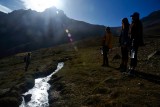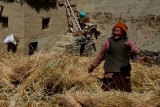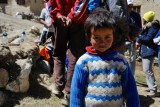Breaking the Cycle in Ladakh
sep 22
#12: Global Himalayan Expedition - Electrification of Ralakung village
Publicado a las 02:16
Blog 9
14th - 20th September
Days 12 - 19
Trekking - 60km (approximate total)
Back in January, in the depth of the severe Ladakhi winter, GHE
performed an electrification expedition in the Zanskar region by
trekking along the frozen Zanskar River (known as the Chadar Trek). As
all roads are impassable during the winter months, the only access to
the Zanskar region is an 8-day trek along the river. The inhabitants of
Ralakung had heard about GHE and the great work it had been doing and
were desperately in need of assistance to improve their living
conditions, including the need to have reliable access the light and
solar power. Three of the village leaders trekked for three or four days
in -30C to -40C temperatures to reach the Zanskar River and then camped
out for a further three days waiting for the GHE expedition to come
through. They were that desperate to get a ‘leg up’! Their request was
for GHE to come to Ralakung, the most remote village in Zanskar to
electrify it and to see their living conditions. In May, when the
weather was less severe (though still snow-bound), GHE sent out a survey
team to assess the situation. The rest is now history!
The logistics for the expedition are huge; 18 international and Indian
participants from 9 countries, the core GHE organisers, led by Jaideep
(Paras could only come for 3 days because he needed to go to Japan for
an important conference), and a large team of local experts -
electricians, guides, cooks and assistants, filmmakers, animal handlers,
and villagers from Ralakung. A part of the agreement was that the
villagers assist the team to carry equipment and supplies to and from
their village.
For the participants, it was very exciting to be finally setting off on
the trek, though there was probably some trepidation because the task
ahead was going to be a serious physical challenge, for many the biggest
challenge of their lives. I was really looking forward to an adventure
of a different kind, my main concern was how my knee would take trekking
down the steeper slopes.
We set off from Phe at around 3628m…the only way was up, up, up,
eventually to 4708m at the first campsite. The trekking was, of course,
spectacular - vast mountains of all sorts of colours, valleys, fast-
flowing streams, some rocky ascents - mostly in sunshine. Tingless, the
highly experienced guide (and mountaineer), paced the group so that we
kept together. I must have appeared as if we were stepping in slow
motion. Ascending for me wasn’t a massive challenge, especially at this
pace, because of my fitness and I was already well-acclimatised. For the
first time I had decided to use two walking poles in order to protect my
knee over the four days of hiking. It took a while to effectively
coordinate legs and poles, as I am a relatively inexperienced trekker,
but I believe the choice of using the poles was a good one.
It was great to get to know the diverse group of teammates over the
journey. There was time to talk during the walking and downtime. Rather
than use the GHE tents, I chose to test my new Mont Australia spacious
1-person tent. I also felt I still needed some of my own space (nothing
against my new friends) because I am still grieving for my Dad.
The second day was a big one. The first task was to climb to the 5226m
pass, the highest point on the expedition. Once on the saddle of the
pass, the weather morphed into a blizzard. The steep slopes were
blanketed with snow making the narrow walking track quite treacherous in
the gusting winds and driving snow. Everyone inched their way forward,
leaning into the mountain, and every corner in the zigzagging path was
slippery and steep. The horses really struggled and I have no idea how
the locals with solar panels strapped to their backs did it.
We lunched at 4700m, then continued gradually downwards over a broad
undulating plain and into a valley. Ralakung actually consists of two
villages, separated by another 4600m pass. From here we had the first
glimpse of the smallest, oldest village, Phema, that consists a four
houses, nestled amongst the high mountains. We were heading for the
larger village, Namga, that consists of seven houses. On the way back,
the electricians were to electrify Phema on their own.
Reaching the top of the Phema - Namga pass, we caught our first glimpse
of Namga, a massive 500m steep descent which was a bit too much for my
knee, but I soldiered on and just did it anyway.
The villagers had been preparing to welcome us for some time. We were
each greeted and honoured traditionally with cuttucks, (white scarves,
unsure of spelling), locally produced chapattis, curds, tea and ground
roasted barley, their man staple, along with some traditional songs by
the women.
Our group was accommodated in the seven houses for both of the nights we
were there; the first night would be without light, (only torches), the
second with light after the electrification. The houses, similar to
several others I have stayed in, are simple, well-organised double story
buildings, made of mud bricks with stone fences (usually topped with
piles of drying dung that they use for fuel during the winter), and the
roofs were made of layers of branches, straw and dry mud, with hay
stacked on top for insulation and the animals to eat during the winter.
Being September, all villagers were preparing for the long isolated
winter, cutting and processing hay.
The village and fields is perched on a fertile patch of land that is
continually being replenished by natural dung fertilisers, surrounded by
the most dramatic natural amphitheatre you could imagine. In the winter
the snow capped mountains reflect light, providing more solar energy
than in the summer.
The next day we were briefed by Jaideep before we were divided into
groups and went to work. Essentially, as the expedition participants
are not expert electricians, we were there to support and perform some
simple tasks to help the GHE team. Our jobs generally included
assembling the light sockets and switches, then liaising with the
owners of each house to see where they would like their eight light
bulbs to be positioned, attaching the light sockets and securing the
wires and solar panels.
In the afternoon, one of the most important interactions we had was
with the local villagers. The whole group sat in a large circle and we
were able to ask questions while the lead filmmaker, Stanzin Gurmet,
translated. There’s too much to write in any detail here, but it seems
the electrification of the village is a great start. There is so much
more that the villagers need to make a better life; education, health
and communications are the keys. They are not money orientated, they
are happy within themselves. If the situation develops, they would be
extremely happy to host more tourists - we were the first tourists to
ever trek to Ralakung - but they would be happy to host just to meet
new people.
There is a school there, but they cannot keep a teacher for any length
of time because of the isolation. Occasionally some of the children are
sent away to school, but they cannot afford to send them all and
usually the girls miss out. Health is a big issue. Last winter, one of
the older women became unwell. They repeatedly called for help on the
one village satellite phone, but could not raise any assistance for an
evacuation. (During election time, the government sends in helicopters
to ensure they have an opportunity to vote, but nothing in a medical
emergency). In the end, four of the strongest men carried the women on
their backs for four days in extreme conditions and got her to Padum
hospital where she died.
With the village all wired up, there was time before it became dark to
wander and entertain ourselves in whatever way we chose - some played
soccer, I took part in a women’s meeting. Then the big moment. We
gathered in the top house and waited for a few visitors from the other
village, Phega, to arrive and join in the festivities. There was in
series of prayers and blessings before the oldest woman in the village
was given the honour of flicking the switch. There was wild excitement.
I stood next to the old lady and she hugged me strongly for a long time.
Her earlier comment (as she danced on her haystack) was that she was so
happy because she would see light in Ralakung before she dies. This made
me feel pretty emotional. We then stepped outside in the clear, cold
night and the remaining houses were lit up. It was very special.
Celebrations lasted well into the night.
The next day we began the return journey reaching the campsite early,
the point at which we had taken our lunch break at the base before the
big climb. At 4700m, it was a freezing night. At -5C, my water bottle
was frozen inside my tent, though I was warm enough.
Thankfully the weather for the final long day of trekking, almost 20km,
was fine, and ascending to 5226m was not the challenge it would have
been had we the same blizzard conditions we’d had on the outward
journey. With Phe in our sights, most of us made it back on foot, others
on horseback.
The women’s association of Phe, a village of 500 people, organised a
reception for us, and later on, a celebration. I think it was something
I ate at the initial reception that didn’t agree, and I was ill twice
that night. Luckily I was just required to sit in a bus for the next two
days, driving to Kargil, then on to Leh. The busses really struggled on
the stony road I had ridden to get there. On the way up, I cycled at
around 10km/hr and on the way back, the busses could travel at around
15km/hr…it was rough!
Now back in Leh, we have concluded the GHE expedition and just about
everyone is returning to their various corners of the world tomorrow,
most will be straight back to work. I have used the day in Leh to
prepare for the second half of my cycle journey, covering the route I
have planned to lead for World Expeditions next year. I will have 9
days to ride over some of the world’s highest passes and to the lakes
of Tso Moriri and Pangong. Jigmet, the cameraman and a new driver will
travel with me.
Not sure when the next blog will be yet.
14th - 20th September
Days 12 - 19
Trekking - 60km (approximate total)
Back in January, in the depth of the severe Ladakhi winter, GHE
performed an electrification expedition in the Zanskar region by
trekking along the frozen Zanskar River (known as the Chadar Trek). As
all roads are impassable during the winter months, the only access to
the Zanskar region is an 8-day trek along the river. The inhabitants of
Ralakung had heard about GHE and the great work it had been doing and
were desperately in need of assistance to improve their living
conditions, including the need to have reliable access the light and
solar power. Three of the village leaders trekked for three or four days
in -30C to -40C temperatures to reach the Zanskar River and then camped
out for a further three days waiting for the GHE expedition to come
through. They were that desperate to get a ‘leg up’! Their request was
for GHE to come to Ralakung, the most remote village in Zanskar to
electrify it and to see their living conditions. In May, when the
weather was less severe (though still snow-bound), GHE sent out a survey
team to assess the situation. The rest is now history!
The logistics for the expedition are huge; 18 international and Indian
participants from 9 countries, the core GHE organisers, led by Jaideep
(Paras could only come for 3 days because he needed to go to Japan for
an important conference), and a large team of local experts -
electricians, guides, cooks and assistants, filmmakers, animal handlers,
and villagers from Ralakung. A part of the agreement was that the
villagers assist the team to carry equipment and supplies to and from
their village.
For the participants, it was very exciting to be finally setting off on
the trek, though there was probably some trepidation because the task
ahead was going to be a serious physical challenge, for many the biggest
challenge of their lives. I was really looking forward to an adventure
of a different kind, my main concern was how my knee would take trekking
down the steeper slopes.
We set off from Phe at around 3628m…the only way was up, up, up,
eventually to 4708m at the first campsite. The trekking was, of course,
spectacular - vast mountains of all sorts of colours, valleys, fast-
flowing streams, some rocky ascents - mostly in sunshine. Tingless, the
highly experienced guide (and mountaineer), paced the group so that we
kept together. I must have appeared as if we were stepping in slow
motion. Ascending for me wasn’t a massive challenge, especially at this
pace, because of my fitness and I was already well-acclimatised. For the
first time I had decided to use two walking poles in order to protect my
knee over the four days of hiking. It took a while to effectively
coordinate legs and poles, as I am a relatively inexperienced trekker,
but I believe the choice of using the poles was a good one.
It was great to get to know the diverse group of teammates over the
journey. There was time to talk during the walking and downtime. Rather
than use the GHE tents, I chose to test my new Mont Australia spacious
1-person tent. I also felt I still needed some of my own space (nothing
against my new friends) because I am still grieving for my Dad.
The second day was a big one. The first task was to climb to the 5226m
pass, the highest point on the expedition. Once on the saddle of the
pass, the weather morphed into a blizzard. The steep slopes were
blanketed with snow making the narrow walking track quite treacherous in
the gusting winds and driving snow. Everyone inched their way forward,
leaning into the mountain, and every corner in the zigzagging path was
slippery and steep. The horses really struggled and I have no idea how
the locals with solar panels strapped to their backs did it.
We lunched at 4700m, then continued gradually downwards over a broad
undulating plain and into a valley. Ralakung actually consists of two
villages, separated by another 4600m pass. From here we had the first
glimpse of the smallest, oldest village, Phema, that consists a four
houses, nestled amongst the high mountains. We were heading for the
larger village, Namga, that consists of seven houses. On the way back,
the electricians were to electrify Phema on their own.
Reaching the top of the Phema - Namga pass, we caught our first glimpse
of Namga, a massive 500m steep descent which was a bit too much for my
knee, but I soldiered on and just did it anyway.
The villagers had been preparing to welcome us for some time. We were
each greeted and honoured traditionally with cuttucks, (white scarves,
unsure of spelling), locally produced chapattis, curds, tea and ground
roasted barley, their man staple, along with some traditional songs by
the women.
Our group was accommodated in the seven houses for both of the nights we
were there; the first night would be without light, (only torches), the
second with light after the electrification. The houses, similar to
several others I have stayed in, are simple, well-organised double story
buildings, made of mud bricks with stone fences (usually topped with
piles of drying dung that they use for fuel during the winter), and the
roofs were made of layers of branches, straw and dry mud, with hay
stacked on top for insulation and the animals to eat during the winter.
Being September, all villagers were preparing for the long isolated
winter, cutting and processing hay.
The village and fields is perched on a fertile patch of land that is
continually being replenished by natural dung fertilisers, surrounded by
the most dramatic natural amphitheatre you could imagine. In the winter
the snow capped mountains reflect light, providing more solar energy
than in the summer.
The next day we were briefed by Jaideep before we were divided into
groups and went to work. Essentially, as the expedition participants
are not expert electricians, we were there to support and perform some
simple tasks to help the GHE team. Our jobs generally included
assembling the light sockets and switches, then liaising with the
owners of each house to see where they would like their eight light
bulbs to be positioned, attaching the light sockets and securing the
wires and solar panels.
In the afternoon, one of the most important interactions we had was
with the local villagers. The whole group sat in a large circle and we
were able to ask questions while the lead filmmaker, Stanzin Gurmet,
translated. There’s too much to write in any detail here, but it seems
the electrification of the village is a great start. There is so much
more that the villagers need to make a better life; education, health
and communications are the keys. They are not money orientated, they
are happy within themselves. If the situation develops, they would be
extremely happy to host more tourists - we were the first tourists to
ever trek to Ralakung - but they would be happy to host just to meet
new people.
There is a school there, but they cannot keep a teacher for any length
of time because of the isolation. Occasionally some of the children are
sent away to school, but they cannot afford to send them all and
usually the girls miss out. Health is a big issue. Last winter, one of
the older women became unwell. They repeatedly called for help on the
one village satellite phone, but could not raise any assistance for an
evacuation. (During election time, the government sends in helicopters
to ensure they have an opportunity to vote, but nothing in a medical
emergency). In the end, four of the strongest men carried the women on
their backs for four days in extreme conditions and got her to Padum
hospital where she died.
With the village all wired up, there was time before it became dark to
wander and entertain ourselves in whatever way we chose - some played
soccer, I took part in a women’s meeting. Then the big moment. We
gathered in the top house and waited for a few visitors from the other
village, Phega, to arrive and join in the festivities. There was in
series of prayers and blessings before the oldest woman in the village
was given the honour of flicking the switch. There was wild excitement.
I stood next to the old lady and she hugged me strongly for a long time.
Her earlier comment (as she danced on her haystack) was that she was so
happy because she would see light in Ralakung before she dies. This made
me feel pretty emotional. We then stepped outside in the clear, cold
night and the remaining houses were lit up. It was very special.
Celebrations lasted well into the night.
The next day we began the return journey reaching the campsite early,
the point at which we had taken our lunch break at the base before the
big climb. At 4700m, it was a freezing night. At -5C, my water bottle
was frozen inside my tent, though I was warm enough.
Thankfully the weather for the final long day of trekking, almost 20km,
was fine, and ascending to 5226m was not the challenge it would have
been had we the same blizzard conditions we’d had on the outward
journey. With Phe in our sights, most of us made it back on foot, others
on horseback.
The women’s association of Phe, a village of 500 people, organised a
reception for us, and later on, a celebration. I think it was something
I ate at the initial reception that didn’t agree, and I was ill twice
that night. Luckily I was just required to sit in a bus for the next two
days, driving to Kargil, then on to Leh. The busses really struggled on
the stony road I had ridden to get there. On the way up, I cycled at
around 10km/hr and on the way back, the busses could travel at around
15km/hr…it was rough!
Now back in Leh, we have concluded the GHE expedition and just about
everyone is returning to their various corners of the world tomorrow,
most will be straight back to work. I have used the day in Leh to
prepare for the second half of my cycle journey, covering the route I
have planned to lead for World Expeditions next year. I will have 9
days to ride over some of the world’s highest passes and to the lakes
of Tso Moriri and Pangong. Jigmet, the cameraman and a new driver will
travel with me.
Not sure when the next blog will be yet.


















































Comentarios